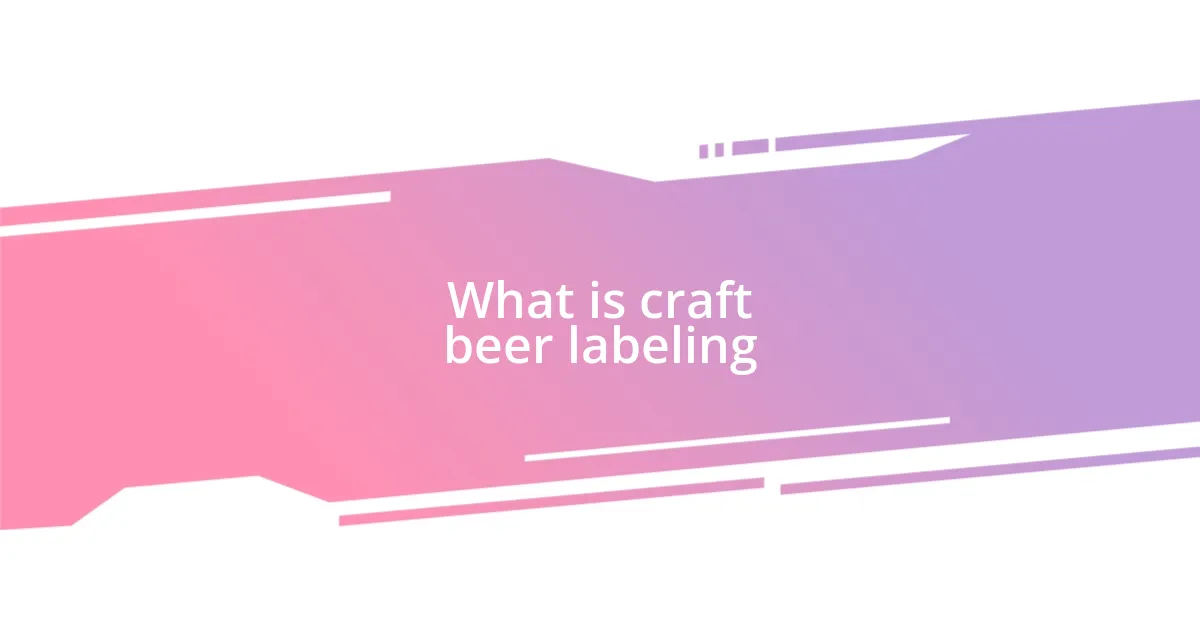Key takeaways:
- Craft beer labeling serves as an artistic expression, reflecting a brewery’s unique identity and connecting with local culture.
- Effective labels enhance consumer experience by conveying flavor profiles, brewing techniques, and brand stories.
- Design elements such as visuals, typography, and sustainability indicators significantly influence consumer choices.
- Current trends in craft beer labeling include minimalism and bold, exaggerated designs, alongside a growing emphasis on eco-friendly practices.

What is craft beer labeling
Craft beer labeling is often seen as an artistic expression that reflects the unique identity of a brewery. Each label tells a story, showcasing not just the beer’s ingredients but also the passion behind its creation. I remember picking up a bottle once, drawn in by a whimsical design that perfectly matched the beer’s funky flavor — it felt like the label was inviting me on an adventure.
What truly fascinates me about craft beer labeling is how it often embodies the culture of the craft beer movement itself. The labels can range from whimsical and playful to artistic and sophisticated, and they often resonate with the local community. Have you ever noticed how many craft beers feature local landmarks or symbols? It’s a beautiful way for brewers to connect with their patrons on a personal level while celebrating their roots.
In a world where commercial beers prioritize uniformity, craft beer labels provide a refreshing burst of creativity. They serve as an entry point for consumers, offering a glimpse into the flavor profile and the brewing process. This connection reminds me of the first time I gleaned insight from a label — it’s as if each one whispers a secret, guiding me to try something exciting and unexpected.

Importance of craft beer labels
Craft beer labels play a critical role in establishing a brewery’s identity. They instantly convey a sense of the brand’s personality and the story behind each brew. I recall a time when I was in a craft beer bar, and I was completely captivated by a label depicting a mythical creature. It sparked my curiosity about the beer itself, compelling me to order it. The label wasn’t just a design; it was a conversation starter.
Additionally, labels act as a guide to the consumer’s experience. They can detail the flavors, aromas, and even the brewing techniques used, helping consumers make informed choices. I remember flipping a bottle over, intrigued by its flavor notes—tropical, hoppy, creamy—and it turned out to be one of those rare finds that exceeded my expectations. The anticipation built from the label was just as enjoyable as the first sip.
Craft beer labels also foster a sense of community among patrons and brewers alike. By incorporating local elements or telling stories that resonate with the area, they create an emotional bond. Once, a craft beer label featured a local legend. I felt an immediate connection, both to the beer and its roots, which made my experience at that brewery unforgettable. It transforms a simple drink into a shared narrative, making each sip richer.
| Aspect | Importance |
|---|---|
| Brand Identity | Establishes brewery’s personality and story. |
| Consumer Guidance | Offers insight into flavor profiles and brewing techniques. |
| Community Connection | Creates emotional ties through local storytelling. |

Key elements of effective labels
Effective craft beer labels are more than mere decorations; they fuse visuals and information to entice and inform. I vividly recall the excitement I felt when I first spotted an intricately designed label featuring a vibrant sunset over a beach. The moment I saw it, I could almost taste the saltiness of the ocean air, evoking memories of summer nights. This emotional connection, I believe, is a key element of effective labeling that draws consumers in and creates a lasting impression.
Here are some fundamental elements that make labels stand out:
- Visual Appeal: Bold colors and unique graphics capture attention and reflect the brewery’s personality.
- Descriptive Language: Clear descriptions of flavor profiles, aromas, and ingredients guide consumers in their choices.
- Brand Story: Integrating the brewery’s history or local culture fosters a deeper connection to the beer.
- Typography: The choice of fonts can convey a mood—whether it’s whimsical, rustic, or sophisticated—adding to the overall theme of the label.
- Sustainability Indicators: Labels that highlight eco-friendly practices resonate with conscious consumers, enhancing brand loyalty.
Every time I see a label that narrates a tale of local roots or a unique brewing process, it rekindles my excitement for discovering new flavors. My experience isn’t just about tasting the beer; it’s about engaging with the story wrapped around it. A well-crafted label can transform a simple bottle of beer into a gateway for a unique experience.

How design influences consumer choice
When I scan the shelves of a craft beer store, my eyes are naturally drawn to the labels that pop out with vibrant colors and creative designs. It’s fascinating how just a visual element can almost whisper promises of adventure and flavor, guiding my choice before I even taste the brew. I once picked a beer purely because the label featured a stunning illustration of a towering mountain—each glance at it stirred a desire for the outdoors, and yes, that beer delivered on taste, enhancing the entire experience.
The font choices on a label can convey a surprising amount of information as well. I remember stumbling upon a stout with an old-timey typeface that suggested a rich history, and it felt like I was about to indulge in a recipe passed down through generations. It got me thinking: how often do we subconsciously associate design choices with quality? That label wasn’t just informative; it was a promise, an invitation to invest in a story I wanted to be a part of.
Then there’s the emotional layer that labels often bring into play. I still can’t shake the memory of holding a bottle that told a heartfelt story about its creation, crafted in honor of local artisans. The sentimental design evoked a sense of community, making me feel like I was contributing to something bigger than just a drink. Isn’t it fascinating how a mere piece of paper can create such a connection? These moments transform our beer consumption from a casual choice into an experience that resonates on a personal level.

Trends in craft beer labeling
From my observations, there’s a growing trend in craft beer labeling that embraces minimalism. A few weeks ago, I encountered a beautiful can that featured a simple color palette and a single artistic element—a delicate line drawing of a hop cone. It struck me how this stripped-back design didn’t just stand out; it offered a refreshing purity that resonated with the current appreciation for craft ingredients and authenticity. Doesn’t it feel great when less is actually more?
On the other hand, we’ve also seen labels leaning into bold and exaggerated art. I remember visiting a local brewery, and their latest release had a wildly colorful label adorned with comic-style graphics. The design was almost like a celebration, buzzing with energy and a playful spirit. It’s interesting to consider whether such vibrant artwork might entice younger consumers or those seeking a unique experience—who doesn’t want to feel like they’re holding a special piece of art in their hands?
Additionally, sustainability is making a noticeable impact on labeling trends. I recently picked up a beer where the label proudly proclaimed it was printed with eco-friendly inks and made from recycled materials. I couldn’t help but feel a connection to the brand’s commitment to the environment. Isn’t it empowering to support products that align with our values? These mindful choices in labeling not only enhance the product’s appeal but also cultivate a sense of trust and responsibility toward future generations.














